Ultimate Guide to Outhouse Toilets: Eco-Friendly and Practical Solutions

The concept of an outhouse toilet, a staple of rural and remote areas, has been around for centuries. Traditionally, these are small structures separate from the main dwelling, providing a basic but essential facility for human waste disposal.
Outhouse toilets have evolved from simple pit latrines to more sophisticated and environmentally friendly designs. In the past, they were often the only option for sanitation in areas without plumbing. Over time, advancements have led to the development of various types of outhouses, including composting toilets, which are more sustainable.
Today, outhouses remain crucial in locations where traditional plumbing is not feasible or where environmental conservation is a priority. They are commonly found in rural homes, campsites, and remote cabins. Outhouses serve not just as a practical solution to a basic human need but also play a significant role in environmental protection by preventing water contamination.

In some cultures, outhouses are more than just a functional space; they represent a connection to a simpler, more self-sufficient way of life. They remind us of the importance of respecting and adapting to our natural surroundings.
Related Post:
Outhouse Construction: Step by Step
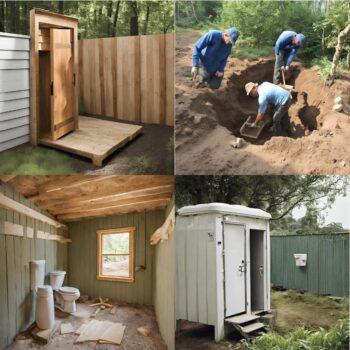
Design and Construction
Designing and constructing an outhouse requires careful planning to ensure functionality, durability, and minimal environmental impact. The design can vary based on personal preferences, environmental conditions, and available materials.
Types of Outhouse Designs:
Traditional Pit Latrines:
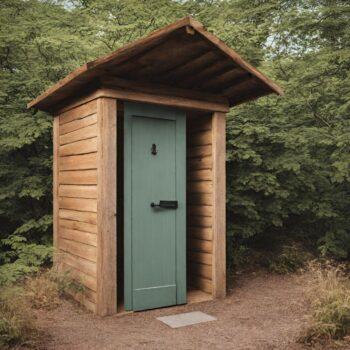
The most basic form, involving a deep pit over which a small structure is built. Simple to construct but requires eventual relocation once the pit is full.
Composting Toilets:
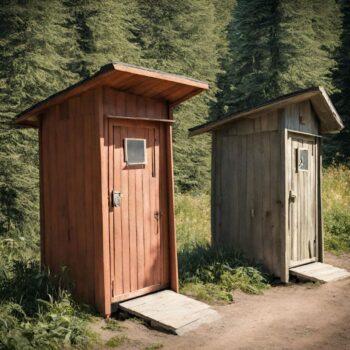
These are more advanced and environmentally friendly. They decompose waste into compost through a controlled process, reducing the need for relocation.
Portable Designs:
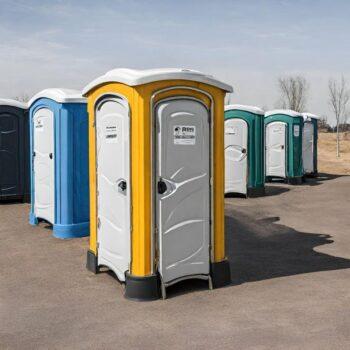
Ideal for camping or temporary sites. These are lightweight, easy to move, and often use chemical or bag systems for waste management.
Outhouse toilets-Materials and Tools:
Common materials include wood for the structure, concrete or bricks for the base, and specific composting toilet components if applicable. Essential tools might include a shovel, hammer, saw, drill, and measuring tools.
Options for eco-friendly and recycled materials can also be considered.
Construction Guide:
- Planning: Start with a clear plan or blueprint, considering the size, ventilation, and door placement.
- Building the Base: Ensure a solid and level base, typically using concrete or stone.
- Pit Digging: For pit latrines, dig a deep enough pit to accommodate several years of use.
- Erecting the Structure: Construct the walls, roof, and door. Proper ventilation is key to reduce odors.
- Finishing Touches: Install the seat or commode. Add any additional features like a coat hook, shelf, or lighting.
Considerations:
- The depth and size of the pit in traditional latrines.
- The choice of composting method and materials for composting toilets.
- Accessibility and comfort, especially in terms of height and space.
Outhouse toilets- Location and Site Preparation
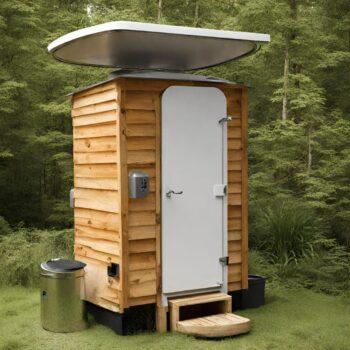
Choosing the Right Location:
- Distance from Water Sources: To prevent contamination, place the outhouse at least 50-100 feet away from wells, rivers, or lakes.
- Soil Type: The soil should be absorbent enough for pit latrines but not so porous that it risks contaminating groundwater.
- Privacy and Accessibility: Ensure the outhouse is conveniently located for users but also offers privacy.
- Orientation: Consider the direction of prevailing winds and sun exposure for comfort and odor control.
Site Preparation Steps:
- Surveying the Area: Identify any underground utilities or obstacles. Assess the land for levelness and drainage.
- Clearing and Leveling: Remove any debris, vegetation, or rocks. Level the ground to provide a stable base.
- Marking the Area: Outline the dimensions of the outhouse on the ground, including the pit area if applicable.
Environmental Considerations:
- Avoid areas prone to flooding, as this can lead to environmental contamination and structural issues.
- Consider the impact on local wildlife and vegetation, minimizing disruption to the natural habitat.
Legal and Regulatory Compliance:
- Check local regulations regarding sanitation, waste disposal, and construction in outdoor areas.
- Obtain any necessary permits or approvals before beginning construction.
- This section outlines the key considerations for selecting and preparing a site for an outhouse toilet. It’s important to balance practicality with environmental and legal factors.
Outhouse toilets- Maintenance and Upkeep
Regular Cleaning and Maintenance:
- Cleaning Schedule: Establish a routine cleaning schedule to maintain hygiene. This includes sweeping, wiping surfaces, and checking for structural damage.
- Waste Management: For pit latrines, monitor the level of waste and plan for eventual pit closure and relocation of the outhouse. For composting toilets, regularly check and manage the composting process according to the manufacturer’s guidelines.
- Ventilation Maintenance: Ensure that ventilation systems are clear and functioning to minimize odors.
Odor Control and Insect Prevention:
- Natural Odor Control: Use lime, ash, or sawdust in pit latrines to reduce odors and accelerate decomposition.
- Insect Control: Regularly inspect for and address any insect infestations. Seal gaps or cracks where insects might enter.
Seasonal Considerations:
In colder climates, insulate the outhouse to prevent freezing in winter.
In warmer climates, focus on enhanced ventilation and shading to keep the outhouse comfortable.
Repair and Renovation:
Regularly inspect the structure for any damage or wear and perform necessary repairs.
Consider renovations or improvements, such as better seating, improved doors, or aesthetic enhancements to make the space more comfortable and inviting.
Record Keeping: Keep a log of maintenance activities, especially for composting toilets, to track the health of the system and anticipate future needs.
Outhouse toilets- Environmental Considerations
Impact on the Environment:
Understand that outhouses, especially pit latrines, can have environmental impacts, such as soil and water contamination if not properly managed.
Composting toilets offer a more sustainable solution by recycling waste into usable compost, minimizing environmental harm.
Sustainable Practices:
- Eco-Friendly Materials: Use sustainable or recycled materials for construction and maintenance.
- Chemical Usage: Avoid or minimize the use of harmful chemicals for cleaning and odor control. Opt for natural, biodegradable alternatives.
Outhouse toilets- Water Conservation:
Emphasize the water-saving advantage of outhouses, as they typically do not use water for flushing, unlike traditional toilets.
Soil Health:
For pit latrines, ensure the pit is not too deep to reach groundwater levels. The soil should be capable of slowly absorbing and decomposing the waste.
For composting toilets, follow best practices for compost management to enrich soil health.
Wildlife Protection:
Construct and maintain outhouses in ways that do not disturb local wildlife or natural vegetation.
Be mindful of not attracting animals with waste or compost.
Educating Users:
Provide clear guidelines for users on how to use the outhouse responsibly to minimize environmental impact.
Encourage practices like not throwing non-biodegradable items into the toilet.
Future Considerations:
Stay informed about new technologies and methods that could further reduce the environmental footprint of outhouses.
Outhouse toilets- Health and Safety Guidelines
Safe Usage of Outhouse Toilets:
- Proper Use: Educate users on correct usage practices to maintain hygiene, such as not throwing non-degradable items into the toilet.
- Child Safety: Ensure that the outhouse is safe for children, with secure seating and, if necessary, a lock to prevent unsupervised access.
Hygiene Practices:
- Hand Washing: Emphasize the importance of hand hygiene. Consider setting up a hand washing station nearby with soap and water or hand sanitizer.
- Sanitization: Regularly sanitize surfaces, especially those frequently touched, to prevent the spread of germs.
Waste Handling and Disposal:
- For composting toilets, follow safe procedures for handling and using compost to avoid health risks.
- In the case of pit latrines, plan for safe and sanitary closure and relocation when the pit is full.
Disease Prevention:
Understand the potential for disease transmission in unsanitary conditions and take steps to mitigate these risks, particularly in communal or public-use outhouses.
Emergency Preparedness:
Have a plan for dealing with blockages, overflows, or other emergencies. This might include tools on hand or a contact for professional services.
Signage and Instructions:
Post clear instructions and health warnings inside and outside the outhouse. This can include usage guidelines, hygiene reminders, and warnings about potential hazards.
Accessibility:
Ensure that the outhouse is accessible to all users, including those with mobility challenges. Consider features like ramps, handrails, and adequate space inside.
Outhouse Toilets- Legal and Regulatory Aspects
Understanding Local Regulations:
- Sanitation Laws: Research and adhere to local and state laws regarding outdoor sanitation facilities. This can include regulations on the construction, location, and maintenance of outhouses.
- Environmental Compliance: Be aware of environmental laws that govern waste disposal, especially concerning groundwater protection and soil contamination.
- Building Permits and Approvals:
Note: In many regions, constructing an outhouse requires a permit. Ensure you obtain all necessary approvals before beginning construction.
Understand the specific requirements for permits, such as site plans, design specifications, and environmental impact assessments.
Compliance with Public Health Standards:
Adhere to public health guidelines to ensure that the outhouse does not pose a health hazard to users or the community.
This includes regulations on waste disposal and handling, especially for composting toilets.
Accessibility Standards:
Be aware of any legal requirements for making sanitation facilities accessible to individuals with disabilities, which might include features like ramps and handrails.
Regular Inspections:
Depending on the location, outhouses may be subject to periodic inspections by health or environmental officials. Stay informed about these requirements and prepare accordingly.
Staying Informed:
Keep updated on changes in laws and regulations. Attend community meetings or subscribe to local government newsletters for updates.
Outhouse Toilets- Alternatives and Modern Innovations
Overview of Modern Alternatives:
- High-Tech Composting Toilets: These systems use advanced technology to speed up the composting process and reduce odors, making them suitable for more frequent use or smaller spaces.
- Solar-Powered Toilets: These toilets use solar energy to treat waste, offering a sustainable and often self-sufficient solution.
- Portable Chemical Toilets: Widely used in camping and temporary setups, these toilets use chemicals to neutralize waste, making them convenient for transport and use in various locations.
Technological Advancements:
- Waste to Energy Systems: Some modern outhouses are equipped to convert waste into energy, such as biogas, which can be used for heating or cooking.
- Smart Sanitation Solutions: Incorporation of technology like sensors and IoT devices for monitoring waste levels, usage patterns, and even for remote maintenance alerts.
Environmental Impact:
Evaluate the ecological footprint of these modern solutions compared to traditional outhouses. While they offer advantages, it’s important to balance technology with sustainability.
Cost and Accessibility:
Consider the initial investment and ongoing maintenance costs of these modern alternatives. While they offer enhanced functionality, they may not be feasible for all users or locations.
Future Trends:
Stay informed about emerging sanitation technologies that might offer better waste management, lower environmental impact, or increased user comfort.
Look for innovations that align with global sustainability goals and can address sanitation challenges in diverse settings.
Conclusion-the Importance of Outdoor Sanitation
The guide underscores the vital role that outhouse toilets play in providing safe, sustainable sanitation, especially in areas without access to conventional plumbing.
Emphasizing Sustainable Practices:
Highlighting the environmental considerations and the importance of choosing eco-friendly options reinforces the need for responsible sanitation practices. Whether it’s through traditional pit latrines or modern composting solutions, the focus is on minimizing environmental impact and promoting hygiene.
Encouraging Responsibility and Adaptation:
The guide encourages readers to be mindful of their environmental footprint, adhere to health and safety standards, and comply with legal regulations. It also suggests staying informed about advancements in sanitation technology, which could offer more efficient and sustainable solutions in the future.
Reflecting on Cultural and Practical Aspects:
Acknowledging the cultural significance of outhouses in certain communities, the guide respects their traditional value while advocating for improved practices that align with modern environmental and health standards.




